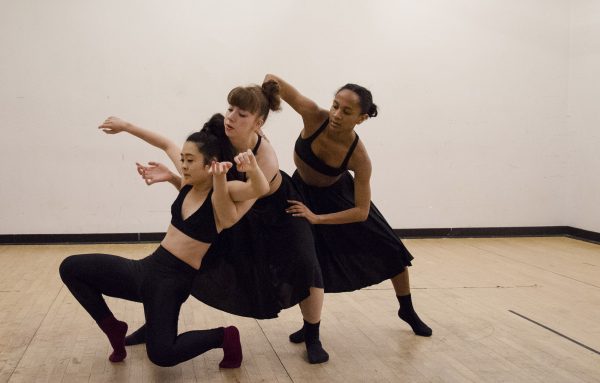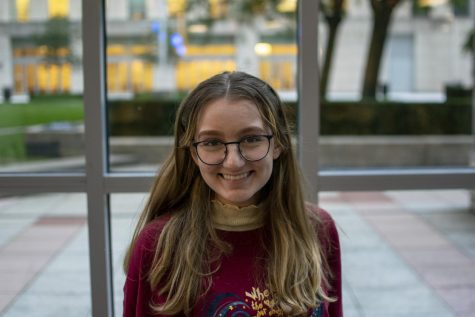Fordham Students Excel at ARS Nova Showcase
Students presented their research in subjects ranging from mental disorders to the Late Roman Republic. (ANDRONIKA ZIMMERMAN/ THE OBSERVER)
April 14, 2017
On April 6, Fordham College at Lincoln Center (FCLC) presented its annual ARS Nova Arts and Research Showcase, where dozens of students displayed their research projects and artistic endeavors. Hosted on the ground floor of the Lowenstein building and wrapping around the entirety of the hallway, many students presented their work in different ways: on tri-boards, in an interpretive dance in the White Box Studio, through art in the Ildiko Butler Gallery and in Franny’s Space, or in engaging discussions at the Kehoe Theatre their creative projects.
As viewers walked around to the exciting sounds of the Fordham Jazz ensemble in the Lowenstein lobby, classmates presented their research, both completed or in its final stages, to inquisitive individuals. Students of all graduating classes were able to learn about many different senior theses and research projects and view various artistic endeavors from their talented classmates.
Anna Barbano, a senior at Fordham College Lincoln Center (FCLC), presented her piece, entitled Comparing Different Approaches to the Diagnosis of Post-Traumatic Stress Disorder (PTSD). Her study examined the concordance of posttraumatic stress disorder (PTSD) diagnoses according to the diagnostic criteria used in the previous version of the Diagnostic and Statistical Manual of Mental Disorders, the DSM-IV, and the new edition, the DSM-5. She analyzed the agreement using DSM-IV and DSM-5 criteria applied to the Harvard Trauma Questionnaire (HTQ), the clinical cut-off score of 2.5 for the HTQ, and diagnoses based on an unstructured clinical interview. Her sample consisted of 333 refugees seeking treatment at NYU Langone/Bellevue Hospital’s Program for Survivors of Torture. She did not find a significant difference in the identification of PTSD between DSM-IV and DSM-5 criteria, but she did find substantial disagreement between the rates of diagnoses based on clinicians’ intake assessments and self-report measures. She postulates that this may reflect either a lack of stringent adherence to the DSM criteria or a greater cultural sensitivity.
“I am here [at the ARS Nova event] because of the Dean’s Research Grant, which allowed me to conduct my research,” Barbano explained. “I applied for these grants and was awarded the funds to stay in New York and conduct this research, and part of that is to present at the ARS Nova Research Fair.”
Fiona Ball, FCLC ’17, presented her research, titled Religiosity, Spirituality, and Well-Being in Lesbian, Gay, and Bisexual Catholics, where she explored the correlation of well-being among LGBTQ members of the Catholic population. Ball hypothesized that there would be a difference between extrinsic and intrinsic religiosity due to identity integration among those who can reconcile their religion and sexuality versus those who are battling between inherently contradictory identities (for those in the LGBTQ community). While her analysis and final data count is not yet complete, her work with Dr. David Glenwick is the first of its kind to explore the relationship between sexuality and spirituality within the Catholic faith.
Ball said that the ARS Nova Exhibition “was easy [to apply for], I was doing this for my thesis and already had the abstract and I’m so interested in the psychological aspect of the impact on one’s well-being because both communities are such strong markers of defining who you are.”
Yint Hmu, FCLC ’17, also presented his senior thesis entitled Reflections on Sulla: A Conservative Purge of the Late Roman Republic c. 80s B.C.E. He explored the reign of Lucuis Cornelius Sulla and found that with the increase of Italian territory, the growing wealth inequality within the economy was the biggest reason contributing to the downfall of this seemingly perfect government.
“As a Political Science and Classics double major, I’ve always been fascinated with the republic as a form of government,” Hmu said. “What better way to study a republic than Rome, the foundation of all of today’s forms of government, and I wanted to explore why this ideal government as I see it fell.”
Hmu expressed his appreciation for the opportunities available at Fordham’s ARS Nova event. “It’s a very unique opportunity, and I’m very glad that this exists for students presenting their senior theses or other research work, who would never be able to present their findings or gain experience presenting otherwise.”
I am happy to be here and I think it’s a good opportunity for students to be able to present their research because that’s something you can put on a resume and it sounds really impressive,” Ball agreed. “I think it’s a really good opportunity to show off their hard work and research.”
In addition to the presentations of senior theses, many other artistic endeavors were displayed, from design showcases to paintings to dance performances. Katherine Liu, FCLC ’19, presented a piece danced by Sumire Ishage, Tori Hey and Sophia Parker. “It’s a narrative of a pilot who’s stranded on a new planet that’s been discovered in the solar system, and how she interacts with the environment that she’s placed in,” she explained. The interpretive dance piece was incredibly moving and widely well received by the audience.
The ARS Nova Arts and Research Showcase was a brilliant way to explore the creative and intelligent minds present within the Fordham community. While it was unfortunately a one-day event, there is no telling what research students will present at next year’s show.











